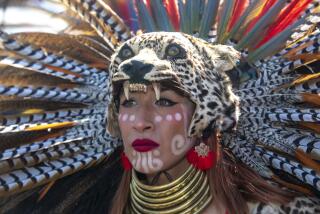The Sweet Fruit of Kwanzaa : Celebration of African Principles Harvests Community Pride, Bridges ‘Cultural Gaps’
- Share via
SANTA ANA — Robert Manuel’s voice carries when he spins a tale. His message resonates even more powerfully.
Manuel left his aerospace engineering job in 1993 to pursue his passion: to become a professional African storyteller and historian. On Saturday, his oratorical skills captivated the audience in the Santa Ana Valley High School auditorium where the fifth annual Kwanzaa Celebration was held.
“Our principles in Kwanzaa are shared in many other practices,” Manuel said. The storyteller added, “Kwanzaa is for all people who want to find depth and success in life.”
Saturday’s event, sponsored by the African Cultural Arts Council, drew nearly 400 people, council President Willia Edmond said.
The elaborate program, in cooperation with the Bowers Museum of Cultural Arts, included storytelling, historical presentations, a fashion show of traditional African dress and thunderous drumming and other musical presentations.
Kwanzaa, which means “first fruits of the harvest” in Swahili, began Friday and continues through Thursday. It was founded by Maulana Karenga, chairman of the black studies department at Cal State Long Beach in 1966, following the Watts riots.
Neither religious nor political, Kwanzaa celebrates African heritage and living a virtuous life, Manuel said. Each day of Kwanzaa corresponds to a different principle. They are: unity, self-determination, collective work and responsibility, cooperative economics, purpose, creativity and faith.
*
During a presentation of the seven principles, 13-year-old Daren Jackson lighted a red candle representing Kuumba, which means creativity.
“Kwanzaa is one of the most important holidays to me,” the Anaheim teen said. “It teaches you to use your own spirit to enhance everything around you.”
Pleased with the turnout, organizer Edmond said, “The Kwanzaa celebration is an opportunity for us to do things as a community, and to bridge cultural gaps.”
More to Read
Sign up for Essential California
The most important California stories and recommendations in your inbox every morning.
You may occasionally receive promotional content from the Los Angeles Times.













